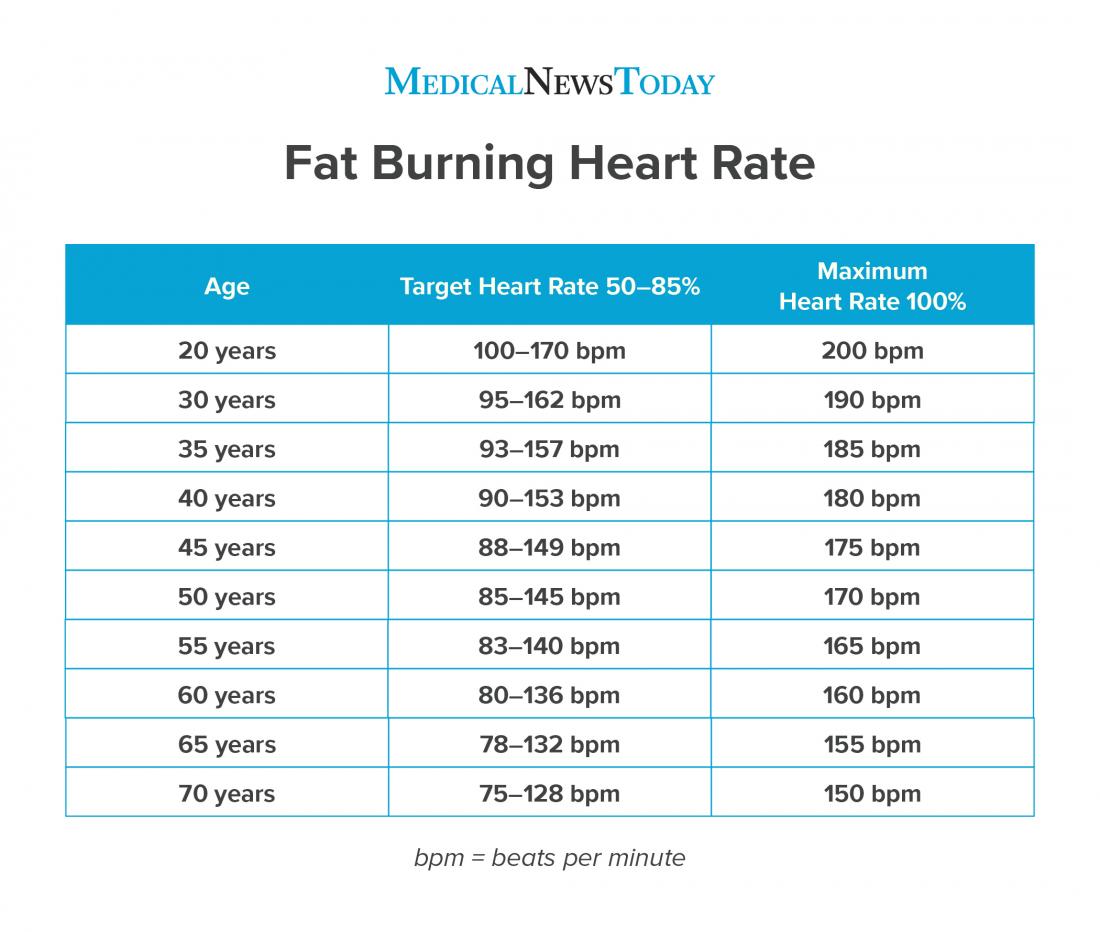The fat burning heart rate is the rate at which a person’s heart should beat per minute to achieve maximum fat burning results. Charts and calculations can help work out an individual’s likely fat burning heart rate for their age.
Fitness professionals and people looking to get in shape often talk about the fat burning heart rate. For people looking to lose weight, hitting a fat burning heart rate could sound like an excellent idea.
While there may be evidence to suggest that this method primarily burns fat, there are more factors that a person should consider when working out.
Keep reading for more information on a fat burning heart rate and whether it is effective for weight loss.

A person’s heart rate is often a good indicator of the intensity of the exercise or activity that they are doing.
When sitting or lying down, a person’s heart rate is usually
When a person exercises, their heart rate starts to increase. A person’s maximum heart rate is the highest heart rate a person can safely achieve, often during high intensity exercises.
Most people working at this intensity will have shorter workouts because it is hard to maintain.
The fat burning heart rate supposedly falls between these two extremes. When a person is hitting their fat burning heart rate, their body is burning more stored fat than sugar and other carbohydrates.
As a result, people often focus on reaching the fat burning zone when they exercise to burn the maximum amount of fat.
There is an equation for figuring out a person’s maximum heart rate and fat burning heart rate. The fat burning heart rate is based on the maximum heart rate.
It is important to note that these equations are not suitable for determining safe heart rates for children.
To calculate the maximum heart rate, a person should subtract their current age from
To calculate the fat burning heart rate zone, a person should determine the upper and lower limits. The upper limit is 70% of the maximum heart rate. The lower limit is about 50% of the maximum heart rate.
Using the same example, a 40-year-old’s fat burning heart rate is between 90 (50% of 180) and 126 (70% of 180) beats per minute.
People interested in increasing their endurance and cardiovascular strength often train at higher levels. Sometimes called the cardio zone, people training for performance increases often train at 70–85% of their maximum heart rate.
The following chart shows the breakdown of heart rates based on a person’s age.

The fat burning heart rate zone has some merit, but it is limited, and some people may rely on it too much. The idea of the fat burning heart rate zone is based on how the body burns fuel when exercising.
In general, the higher the heart rate, the more fat the body burns compared with other calorie sources, such as carbohydrates.
This has led many to believe that hitting and staying in the fat burning heart rate zone is the best way to burn fat and lose weight. However, the reality is more complex.
According to an
The authors also found that these heart rate “zones” had considerable overlap, and that people could get similar results from any heart rate, as long as they were exercising.
The American Council on Exercise (ACE) caution against relying too heavily on the fat burning heart rate. The ACE point out that calculating maximum heart rate based on 220 is not very accurate, since many more factors than age alone determine a person’s fitness level.
They suggest that a person should work with a fitness trainer to help determine their exercise capabilities.
The ACE also have their own heart rate chart that shows heart rate zones based on age and the fitness level of the person.
Like the authors of the 2009 study, the ACE also point out that a person will burn fat regardless of whether they are in the fat burning or cardio zone during exercise. It likely makes little difference which “zone” a person is in when it comes to burning fat and losing weight.
Still, for some, keeping an eye on their heart rate during exercise can help them maintain their intensity or pick up their pace if the activity is not challenging enough.
A person should always speak to a doctor before starting a new exercise program. A doctor or other healthcare provider can recommend healthy heart rate levels and other tips for people who are looking to lose weight.
A person’s fat burning heart rate falls within a range of values based on their age. However, people will burn calories and fat regardless of their heart rate when exercising.
A person who is interested in burning fat should discuss their goals with a doctor, who can recommend exercises and safe heart rates based on their needs and fitness levels.
